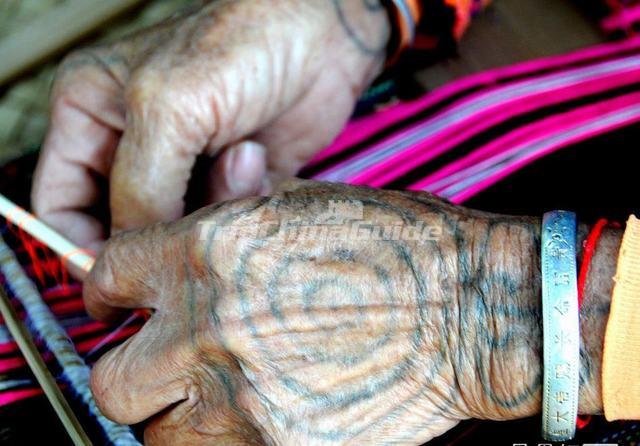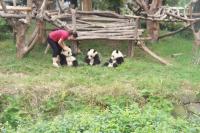Li Ethnic Group
The Li people are one of the ancient nationalities and one of the 56 ethnic groups officially recognized by China’s government. Li people are one of the Lingnan ethnic groups in China, given priority to with agriculture. Li women are good at spinning, Li brocade and Li sheet is famous in the world.
Population
1,463,064(2010)
Main Areas Inhabited by Li
Hainan, China's second largest island after Taiwan, is the home of the Li ethnic group. Most of them live in and around Tongze, capital of the Hainan Li-Miao Autonomous Prefecture, and Baoting, Ledong, Dongfang and other counties under its jurisdiction; others live among people of the Han and Hui ethnic groups in other parts of the island.
Climate and Resources
Lying at the foot of the Wuzhi Mountains, the Li area is a tropical paradise with fertile land and abundant rainfall. Coconut palms and rubber trees line the beaches and people in some places reap three crops of rice a year and grow maize and sweet potatoes all the year round. The area is the country's major producer of tropical crops such as coconut, arica, sisal hemp, lemon grass, cocoa, coffee, rubber, oil palm, cashew, pineapple, cassava, mango and banana.
The island is abundant in minerals like copper, tin, crystal quarts, phosphorus, iron and tungsten. There are numerous salt pans and many fine harbors along the coast, and good fishing grounds off the shore. Pearls, coral and hawksbill, turtles of commercial value are found in the coastal waters. Black gibbons, civets and peacocks live in the primeval forests which abound with valuable timber trees.
Language
The Lis had no written script. Their spoken language belongs to the Chinese-Tibetan language family. But many of them now speak the Chinese language. A new Romanized script was created for the Li ethnic group in 1957 with government help.
History
According to historical records, the term "Li" first appeared in the Tang Dynasty (618-907). The Lis are believed to be descendants of the ancient Yue ethnic group, with especially close relations with the Luoyues -- a branch of the Yues -- who migrated from Guangdong and Guangxi on the mainland to Hainan Island long before the Qin Dynasty (221-206 B.C.). Archaeological finds on the island show that Li ancestors settled there some 3,000 years ago during the late Shang Dynasty or early Zhou Dynasty when they led a primitive matriarchal communal life. Ethnically, the Lis are closely related to the Zhuang, Bouyei, Shui, Dong and Dai ethnic groups, and their languages bear resemblance in pronunciation, grammar and vocabulary. People of the Han ethnic group began to settle on the island also before the Qin Dynasty as farmers, fishermen and merchants. Together, people of the two ethnic groups contributed to the development of Hainan. Later, the Han Dynasty sent troops under Lu Bode and Ma Yuan to set up prefectures and strengthen government control there and enhance relations between the mainland and the island.
In the 6th century, Madame Xian, a political leader of the Yues in southwest Guangdong, Hainan and the Leizhou Peninsula, pledged allegiance to the Sui Dynasty. Her effort in promoting national unity and unification of the country not only enhanced the relationship between Hainan Island and the central part of China but also helped the development of the primitive Li society by introducing feudal elements into it.
The Tang Dynasty (618-907) further strengthened central control over the Li areas by setting up five prefectures which consisted of 22 counties. In the Song Dynasty (960-1279), rice cultivation was introduced and irrigation developed, and local farmers were able to grow four crops of ramie annually. Brocade woven by Li women became popular in central China.
In the early Yuan Dynasty, Huang Daopo, the legendary weaver in Chinese history, achieved her excellence by learning weaving techniques from the Lis. Running away as a child bride from her home in Shanghai, she came to Hainan and lived with the Lis there. Returning to Shanghai, she passed on the Li techniques to others and invented a cotton fluffer, a pedal spinning wheel and looms, which were the most advanced in the world at the time.
The feudal mode of production became dominant in Hainan during the Ming and Qing dynasties as elsewhere in China. Most of the land was in the hands of a small number of landlords, and peasants were exploited by usury and land rent. Large tracts of land were seized by the government for official use. Only in the Wuzhi Mountains did people still work the land collectively, but even this remnant of the communal system was used by feudal landlords as a means of exploitation.
Heavy oppression of the Li people kindled flames of uprising. In the Song and Yuan dynasties, the Lis in Hainan staged 18 large-scale uprisings; during the Ming and Qing dynasties 14 major rebellions took place. After the Opium War in 1840, Hainan was invaded by foreign imperialists who brought untold sufferings to the local Li and Han people, who rose repeatedly against feudal lords and foreign invaders.
The first worker-peasant democratic county government in Hainan was founded there, and revolutionary base areas were set up in the rural areas. Soon afterwards, the Qiongya Worker-Peasant Revolutionary Army was formed.
The Japanese invaded Hainan Island in February 1939. People of various nationalities in Hainan rose in resistance. In the spring of 1944, an anti-Japanese guerrilla force -- the Qiongya Column -- was formed. It grew into an army of 7,000 towards the end of the war, liberating three-fifths of the island.
Clothing
Li women wear button less blouses and tight-fitting long skirts. Women in some places wear pullovers. They do their hair in a coil at the back and pin it with bone hairpins and wear embroidered kerchiefs. They like silver jewelry, and some still tattoo their faces. Men wear collarless jackets, and those in Dongfang County wear much the same kind of jackets as women.
Food
The Li people like roast meat and pickled sour meat mixed with rice meal and wild herbs. Arica is a favorite with women, who chew it with shell ashes wrapped in green leaves; the juice dyes their lips red. The Lis are also heavy smokers and drinkers.
Family and Marriage
Several families related by blood live together, pooling their labor and sharing the harvest. They dwell in boat-shaped thatched bamboo houses with woven bamboo or rattan floors half a meter above the ground. These houses have mud plastered walls.
The Li people are monogamous, and close relatives are not allowed to marry each other. Before liberation in 1949, marriages were arranged by parents when their children were still young and bride prices were as high as several hundred silver dollars or several head of cattle. Those who could not afford the bride price were indentured to the bride's family for several years. Shortly after the wedding, the bride went back to live with her own parents until she knew she had become pregnant. These old customs have gradually gone out of practice since liberation.
Funeral
Death was announced by the firing of guns, and the body was put into a coffin hewed out of a single log and was buried in the village cemetery.
Religion
Before 1949, animism and ancestor worship were common among the Lis who also believed in witchcraft. All this has been abolished since the island was liberated in 1950.
Skill and Calendar
The Lis are known for their skill in weaving kapok. They are also famed for their knowledge of herbal medicine. Their remedies for snakebites and rabies have proved very effective.
They keep a primitive calendar and calculate according to a 12-day cycle, with each day named after an animal, similar to the 12 earthly branches used by the Han people.
Socio-economic Conditions
The Li economy was backward and development was lopsided before liberation in 1949. Over 94 per cent of the Li area was in semi-colonial, semi-feudal society and the landlord economy was fairly developed. In general, the level of development in agriculture and handicraft there was lower than that of the Han areas, so were commerce and animal husbandry. People were impoverished under feudal exploitation and the Kuomintang government's heavy taxation.
In the heart of the Wuzhi Mountains, 13,000 Lis still lived a primitive communal life of collective farming by the time of liberation. A communal farm consisted of several families related by blood. They worked collectively and shared the harvests. This area was more backward than the rest of the island economically. The communal farms -- the "Hemus" -- fell into two major categories: smaller farms based on maternal or paternal blood relations and larger farms which admitted "outsiders" who had no blood ties with the original member families.
Each commune had a headman who was in charge of production and distribution and officiated at religious ceremonies with his wife's assistance. He was also a social leader who mediated disputes and was empowered to admit "outsiders" as communal members. Headmen and members were equals in the old days but, under the influence of feudalism, some headmen began to seize public grain reserves as their own and exploit "outsiders." Some later became government officials and degenerated into local tyrants.
While farm cattle remained public property, farm tools, hunting and fishing gear and work tools were privately owned by families. With the inception of private ownership of cattle and land, the practice of selling and pawning land became popular, as did the leasing of cattle and land. Rent was paid in kind. The exploitation of hired labor began to appear, and the primitive communal system gave way to serfdom and slavery. The establishment of prefectures and counties accelerated class differentiation among the Li people.
A social unit called "kom" existed for a long time in the Li areas. Koms were different in size, and had strict territorial boundaries between each other. A big kom consisted of several small ones which in turn were usually formed by two villages. Most disputes between the koms arose over infringement of each other's territory for hunting, fishing or wood-cutting purposes. Like many of the communal farms, the koms were based on blood relations, and each had one or several headmen chosen for their administrative ability or seniority. Headmen chaired meetings, settled disputes and formulated regulations. With the growth of the feudal economy, the headmen of the koms gradually came to represent those in power.
Hainan's liberation in May was followed by the campaign to wipe out remaining bandits and fight local despots. The Hainan Li-Miao Autonomous Prefecture was founded in July 1952 and the government provided the local people with seeds, farm tools, cattle and grain to help them develop production. Land reform brought tremendous changes to the Li areas. New water conservancy projects and improved farming methods have contributed tremendously to the growth of the rural economy over the years.
Poor farmers were mostly illiterate in the past. They made knots on ropes or counted beans to keep records and notes. Now school age children can go to school.
Hospitals, epidemic prevention stations and clinics have been set up in the prefecture and all the counties. Smallpox and cholera, once rampant here, have been brought under control while the incidence of malaria which once took the lives of a whole village, has been reduced drastically.
BuildingLi people's building is mostly thatched house, the most representative house is boat house, it is the crystallization of the wisdom of traditional Li people.
Festivals
Love Festival is the grandest Li people's folk traditional festival, is also the good days of Li youth, it was held on the third day of March.
Recommended China Tour Packages
-
5-day Bifengxia Panda Base Volunteer Tour
-
2-day Pingyao Ancient City Tour
-
17-day Highlights of China


















